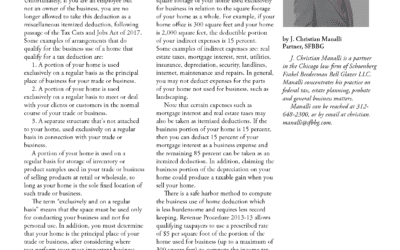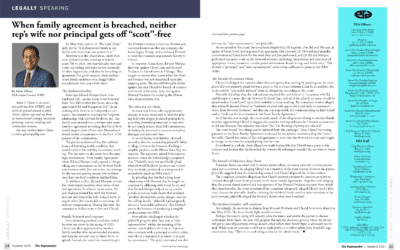Lack of familiarity with fringe benefits can cause business owners to overlook tax-free perks and incentives they could be offering to prospective hires or providing to their current employees (and their spouses and dependent children) at minimal cost. The following article provides a summary of the federal income tax treatment of certain fringe benefits that business owners may want to consider to help attract and retain employees.
Cash payments, bonuses, salary and hourly wages received by an employee are obviously taxed as employment income which must be reported by an employee on his or her federal income tax return. However, under Section 132 of the Internal Revenue Code of 1986 (the “Code”), an employee is generally not required to report as income any employerprovided benefit that falls into one of the following categories: (1) no-additional-cost services; (2) qualified employee discounts; (3) working condition fringe benefits; (4) de minimis fringe benefits; (5) qualified transportation fringe benefits; (6) qualified moving expense reimbursements; (7) qualified retirement planning expenses and (8) reciprocal agreements.
If a benefit does not qualify under one of these exemptions or if the exemption is suspended (for example, qualified moving expense reimbursements and qualified bicycle commuting reimbursements are currently suspended until 2026), the employee must include it in his or her gross income.
No-additional-cost services. A service provided by the employer to the employee at no-additional-cost to the employer may be excluded from tax: (i) if it is the same type of service or property that the employer offers for sale to its customers in the ordinary course of business, and (ii) if it is the same type of service or property offered for sale in the line of business in which the employee works. Examples are hotel accommodations, transportation by aircraft, train, bus or cruise line and telephone services. Certain retired and disabled employees and the surviving spouses of employees are also treated as employees for purposes of this fringe benefit.
Qualified employee discounts. Employers may find it helpful to attract and retain employees by making various goods or services available to their employees at a discount. Often such benefits require the employer to only forego part of the potential profit margin. However, the exclusion does not apply to the following products or services: (i) real property, (ii) property of a kind ordinarily held for investment or (iii) property or services not offered for sale to customers in the ordinary line of business of the employer in which the employee is performing service.
Second, there is a limitation on the size of the discount. For services, the maximum excludible discount is 20 percent of the price at which the employer offers the service to non-employee customers. For products or merchandise, the maximum excludible discount is the employer’s “gross profit percentage.”
Gross profit percentage is defined to be the excess of the aggregate sales price of products sold to nonemployee customers over the aggregate cost of the property, divided by the aggregate sales price. This is generally calculated using the employer’s tax year immediately prior to the tax year in which the discount is available. The employer considers all products offered for sale to customers (including employees) in the line of business in which the employee performs services or some other reasonable classification of merchandise. Because the calculation takes into account aggregate sales, the employer need not make a profit on the specific item or product sold to the employee in order to qualify for the exclusion. As is the case for no-additional-cost services, certain retired and disabled employees and the surviving spouses of employees are also treated as employees for purposes of this fringe benefit.
Working condition fringe benefit. The working condition fringe benefit exclusion recognizes that external factors impacting an employee’s work environment can be directly related to the employee’s ability to perform the job required. A working condition fringe benefit is defined as “any property or services provided to an employee to the extent that, if the employee paid for such property or services, such payment would be deductible as an ordinary and necessary trade-or-business expense (or as depreciation) under Code Sections 162 or 167. Typically, under Code Section 162, items such as computers, vehicles, office space, support staff, tools and supplies are deductible. Therefore, to the extent that such items have been provided by the employer and serve the purpose of getting the employee’s job done, they will fall within the exclusion.
De minimis fringe benefit. Any property or service provided to an employee qualifies as a de minimis fringe benefit if the fair market value of the property or service is so small that accounting for the cost of the property or service would be unreasonable or administratively impracticable. To determine whether the fair market value of the property or service provided is sufficiently small, the frequency with which similar fringe benefits are provided by the employer to all employees must be considered, together with other relevant factors beyond the scope of this article.
An employee’s personal use of an employer-provided cell phone offers an example of how the de minimis fringe benefit exclusion can apply in tandem with the working conditions fringe benefit. If a cell phone is provided to an employee primarily for business reasons, the employee’s use of the cell phone for business reasons is treated as a working condition fringe benefit, and the value of the cell phone usage will be excluded from the employee’s wages. Furthermore, the employee’s personal use of the same phone is excludible from the employee’s income as a nontaxable de minimis fringe benefit.
Qualified transportation fringe benefits. As part of the 1992 Energy Act, Congress sought to provide a tax incentive for employees to use mass transit for commuting. Accordingly, the following categories of fringe benefits qualify for the qualified transportation fringe benefit exclusion: (1) transportation in a commuter highway vehicle if the transportation is in connection with travel between the employee’s residence and place of business, (2) a transit pass, (3) qualified parking or (4) a qualified bicycle commuting reimbursement. Note, however, that qualified bicycle commuting reimbursements must be included in income for tax years 2018 through 2025, and the exclusion from gross income is not available to self-employed individuals. There are two separate limitations for purposes of determining the amount that is excludible from gross income: (1) transportation in a commuter highway vehicle and transit passes are subject to one combined limitation, which is currently $315 for tax year 2024; and (2) qualified parking is subject to a separate limitation, which is also $315 for tax year 2024. The statutory monthly limit on the value of the benefits from each category is adjusted for inflation on an annual basis.
Qualified moving expense reimbursements. Unfortunately, qualified moving expense reimbursements are not excluded from income for tax years 2018 through 2025, except in the case of certain military relocation expenses. However, in 2026, any amount an individual received from an employer as a reimbursement for moving expenses for relocating their home in order to work (and which would be deductible as an employee moving expense if the individual paid or incurred the expenses directly), qualify for exclusion from the employee’s income. However, because these amounts could be deducted by the employee on his or her own tax return, it is important to note that the exclusion does not apply to any employer reimbursement for an expense which the employee deducted in a prior tax year.
Qualified retirement planning services. Employers who provide a “qualified employer plan” to employees may also provide retirement planning services to their employees and their spouses, and such services are excluded from the employee’s gross income. A “qualified plan” refers to employer-sponsored retirement plans that satisfy requirements in the Code for receiving tax-deferred treatment. Most retirement plans offered by employers qualify, including defined contribution plans (e.g., 401(k) plans) and defined benefit plans (e.g., pensions).
Reciprocal agreements. Reciprocal agreements are written agreements between employers to provide fringe benefits for each other’s employees. These agreements allow the benefits provided by employer A for the employees of employer B (and vice versa) to qualify for the exclusion if the services are provided pursuant to a written agreement and neither of the employers incurs any substantial additional cost (including lost revenue) in providing such services. For example, an agreement between two different retail stores to provide employee discounts to each other’s outlets. Special rules apply to on-site parking and athletic facilities located on an employer’s premises.
In addition, while this article summarized the basic fringe benefits a business owner can provide to employees and certain members of their families tax-free, additional types of benefits, including educational assistance plans, dependent care assistance plans and adoption assistance plans, are also available. Business owners knowledgeable of these tax-free benefits will undoubtedly have an edge in hiring prospective applicants and incentivizing existing employees.
Please contact Christian Manalli with any questions at (312) 648-2300 or e-mail at [email protected].



